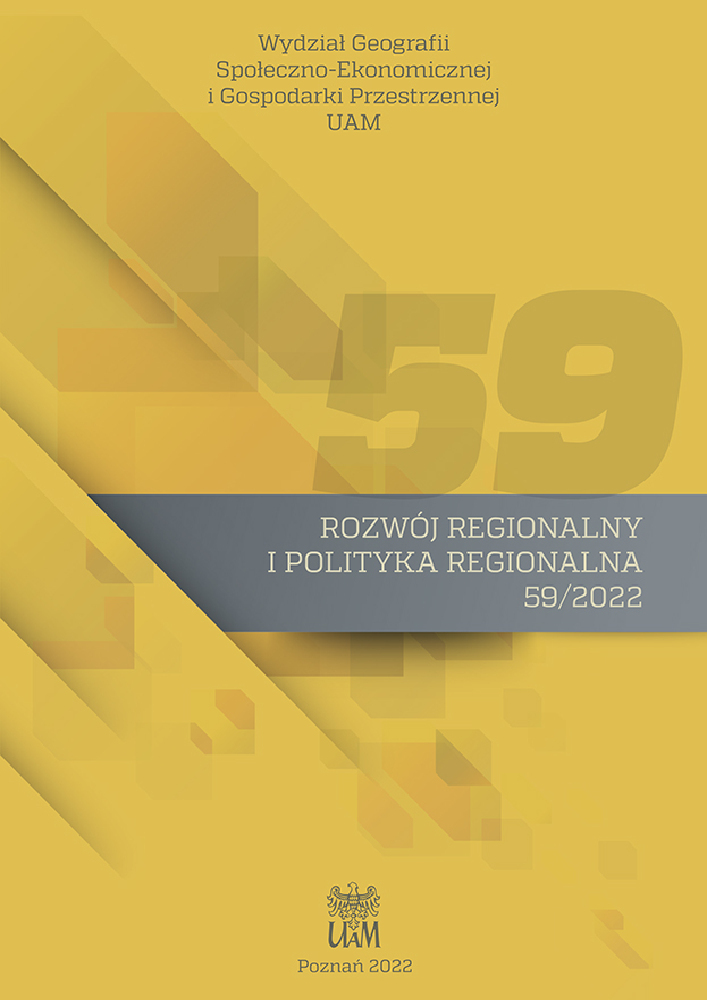Abstract
GDP is widely regarded as a measure of the economic success of countries and regions. The Central Statistical Office provides data on the value of GDP for the whole economy as well as for voivodships and subregions, but information on the level of poviats is not available. Meanwhile, poviats can be treated as closing local economies identified with a given labour market or functional area. Estimating GDP per capita would allow measuring economic activity in these regions. In the presented research the GDP per capita in poviats of łódzkie voivodship was estimated. This indicator is a measure of economic activity, but it does not describe economic and social well-being. A cate- gory more comprehensively describing important aspects of life, such as the quality of health care, the state of the environment, the availability of cultural goods, is the standard of living. Within the framework of the research a ranking of poviats according to the standard of living was created and groups of similar poviats were distinguished. The method of linear ordering according to the first component extracted by PCA method and the k-means method were used. The study was conducted for the years 2019 and 2020. The highest values of GDP per capita were observed in the poviats with city status and the poviats neighbouring Łódź. These poviats were also characterised by the highest standard of living. The group of poviats with the lowest standard of living mainly included the least urbanised ones. The comparison of GDP per capita and living standards showed that these categories are correlated to a moderate degree. In 2020, despite the outbreak of the COVID-19 pandemic, the łódzkie voivodship had the positive, highest dynamics of total gross domestic product in Poland, which translated into the performance of the poviats. The impact of the pandemic was not particularly visible in any of them, in terms of large declines in GDP or living standards.
References
Balicki A. 2013. Statystyczna analiza wielowymiarowa i jej zastosowania społeczno-ekonomiczne. Wyd. 2. Wydawnictwo Uniwersytetu Gdańskiego, Gdańsk.
Bąk A. 2018. Zastosowanie metod wielowymiarowej analizy porównawczej do oceny stanu środowiska w województwie dolnośląskim. Wiadomości Statystyczne, 1(680): 7-20. https://doi.org/10.5604/01.3001.0014.0521 DOI: https://doi.org/10.5604/01.3001.0014.0521
Błoński K., Burlita A., Witek J. (red.) 2017. Pomiar jakości życia na poziomie lokalnym (na przykładzie powiatu wałeckiego). Wydawnictwo Naukowe Uniwersytetu Szczecińskiego, Szczecin.
Brodzicki T., Kuczewska J. 2013. Klastry i polityka klastrowa w Polsce. Konkurencyjność przedsiębiorstw, sektorów i regionów. Wydawnictwo Uniwersytetu Gdańskiego, Gdańsk.
Bywalec C., Rudnicki L. 2002. Konsumpcja. PWE, Warszawa.
Churski P., Perdał R. 2021. Geographical Differences in the Quality of Life in Poland: Challenges of Regional Policy. Social Indicators Research (https://doi.org/10.1007/s11205-021-02829-x). DOI: https://doi.org/10.1007/s11205-021-02829-x
Coyle D. 2014. GDP: A Brief but Affectionate History. Princeton University Press. https://doi.org/10.1515/9781400873630 DOI: https://doi.org/10.1515/9781400873630
Dańska-Borsiak B. 2022. GDP and TFP in poviats of the łódzkie voivodship. Estimation and assessment of variation. Econometrics – Ekonometria – Advances in Applied Data Analysis, 26(1): 14-30 (https://doi.org/10.15611/eada.2022.1.02). DOI: https://doi.org/10.15611/eada.2022.1.02
ESPON 2004. Interim Territorial Cohesion Report. Office for Official Publications of the European Communities, Luxemburg (https://ec.europa.eu/regional_policy/sources/docoffic/official/reports/coheter/coheter_en.pdf).
Eurostat 2011a. Measurement of the quality of life: TF3 Contribution to the summary report of the Sponsorship Group (http://epp.eurostat.ec.europa.eu/portal/page/portal/quality_life/publications).
Eurostat 2011b. Sponsorship Group on Measuring Progress. Well-being and sustainable development. Final Report. European Statistical System Committee (http://ec.europa.eu/eurostat/documents/42577/43503/SpG-Final-report-Progress-wellbeing-and-sustainable-deve).
Fisher W.D. 1958. On Grouping for Maximum Homogeneity. Journal of the American Statistical Association, 53: 789-798. https://doi.org/10.1080/01621459.1958.10501479 DOI: https://doi.org/10.1080/01621459.1958.10501479
Hellwig Z. 1968. Zastosowanie metody taksonomicznej do typologicznego podziału krajów ze względu na poziom ich rozwoju oraz zasoby i strukturę wykwalifikowanych kadr. Przegląd Statystyczny, 4: 307-327.
Hwang C.L., Yoon K. 1981. Multiple Attribute Decision Making: Methods and Applications. Springer-Verlag, New York (https://doi.org/10.1007/978-3-642-48318-9). DOI: https://doi.org/10.1007/978-3-642-48318-9_3
Jenks G.F. 1977. Optimal Data Classification for Choropleth Maps. Occasional. Paper, 2. Department of Geography, University of Kansas.
Majecka A., Nowak P. 2019. Uwarunkowania jakości życia w polskich województwach. Nierówności Społeczne a Wzrost Gospodarczy, 59 (3): 149-161 (https://doi.org/10.15584/nsawg.2019.3.10). DOI: https://doi.org/10.15584/nsawg.2019.3.10
Panek T., Zwierzchowski J. 2019. Analiza porównawcza jakości życia w Polsce w układzie wojewódzkim w ramach podejścia możliwości. Zeszyty Naukowe, Instytut Statystyki i Demografii SGH, 51.
Perkal J. 1967. Matematyka dla przyrodników i rolników. Cz. II. PWN, Warszawa.
Polak E. 2016. Jakość życia w polskich województwach – analiza porównawcza wybranych regionów. Nierówności Społeczne a Wzrost Gospodarczy, 48 (4): 66-89 (https://doi.org/10.15584/nsawg.2016.4.6). DOI: https://doi.org/10.15584/nsawg.2016.4.6
Samuelson P., Nordhaus W. 2010. Economics. 19th ed. McGraw-Hill/Irwin.
Słaby T. 2017. Przegląd koncepcji pomiaru jakości życia ludności. [W:] K. Błoński, A. Burlita, J. Witek (red.), Pomiar jakości życia na poziomie lokalnym na przykładzie powiatu wałeckiego. Uniwersytet Szczeciński, Rozprawy i Studia, (MLV) 981: 19-30.
Smolaga L. 2013. Raport Komisji ds. Wydajności Ekonomicznej i Postępu Społecznego: Błąd pomiaru. Dlaczego PKB nie wystarcza? Zarządzanie, Teoria i Praktyka, 1(7): 200-207.
Sobolewski M., Migała-Warchoł A., Mentel G. 2014. Ranking poziomu życia w powiatach w latach 2003-2012 z uwzględnieniem korelacji przestrzennych. Acta Universitatis Lodziensis, Folia Oeconomica, 6(308): 147-159.
Szaban D. 2019. Poziom życia w powiatach województwa lubuskiego. Wiadomości Statystyczne – The Polish Statistician, 64(11): 25-41. https://doi.org/10.5604/01.3001.0013.7584 DOI: https://doi.org/10.5604/01.3001.0013.7584
Wolak J. 2020. Analiza zmian poziomu życia w powiatach województwa małopolskiego. Metody Ilościowe w Badaniach Ekonomicznych, 21/1: 30-38. https://doi.org/10.22630/MIBE.2020.21.1.4 DOI: https://doi.org/10.22630/MIBE.2020.21.1.4
License
Copyright (c) 2022 Barbara Dańska-Borsiak

This work is licensed under a Creative Commons Attribution 4.0 International License.

